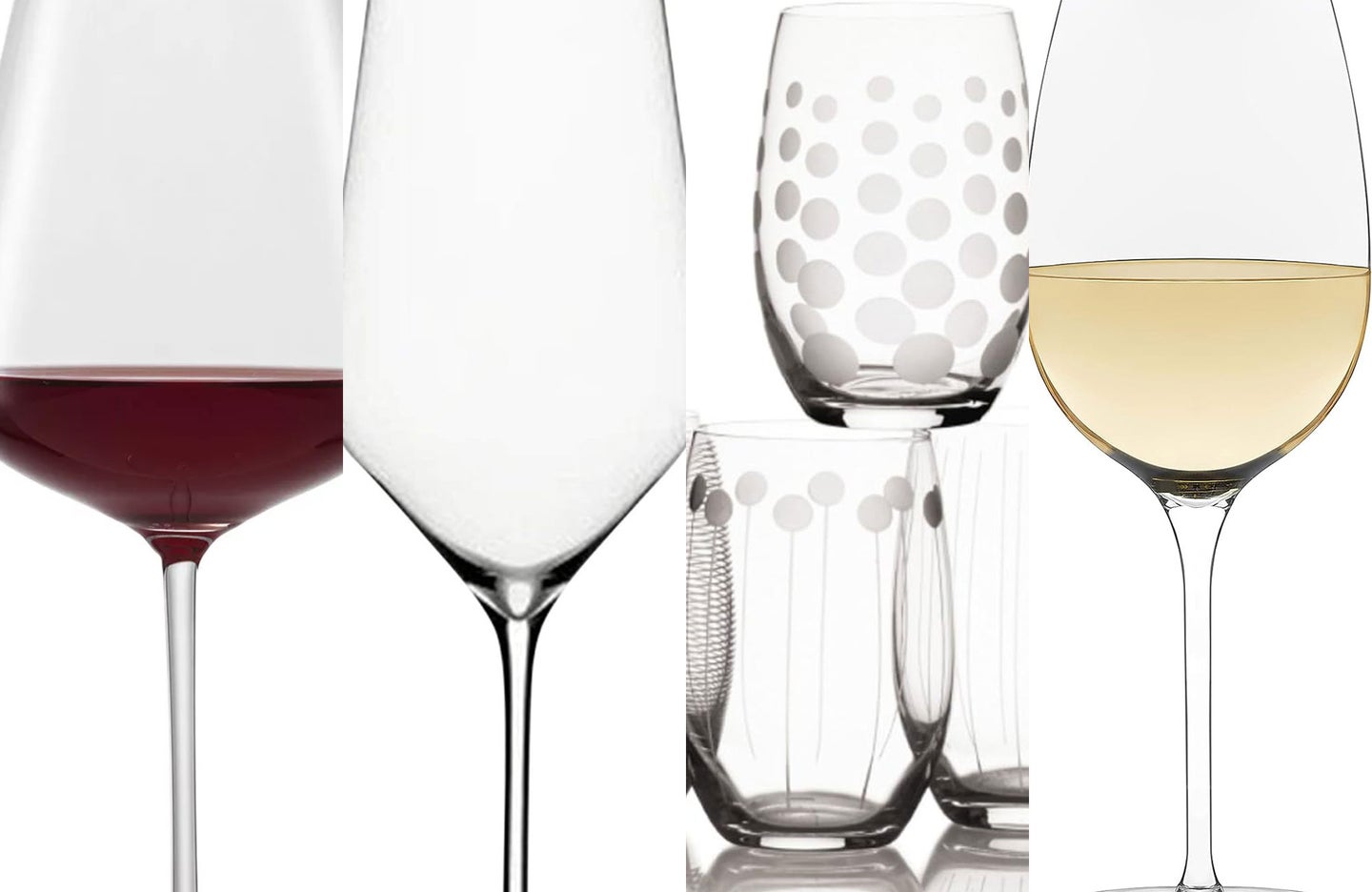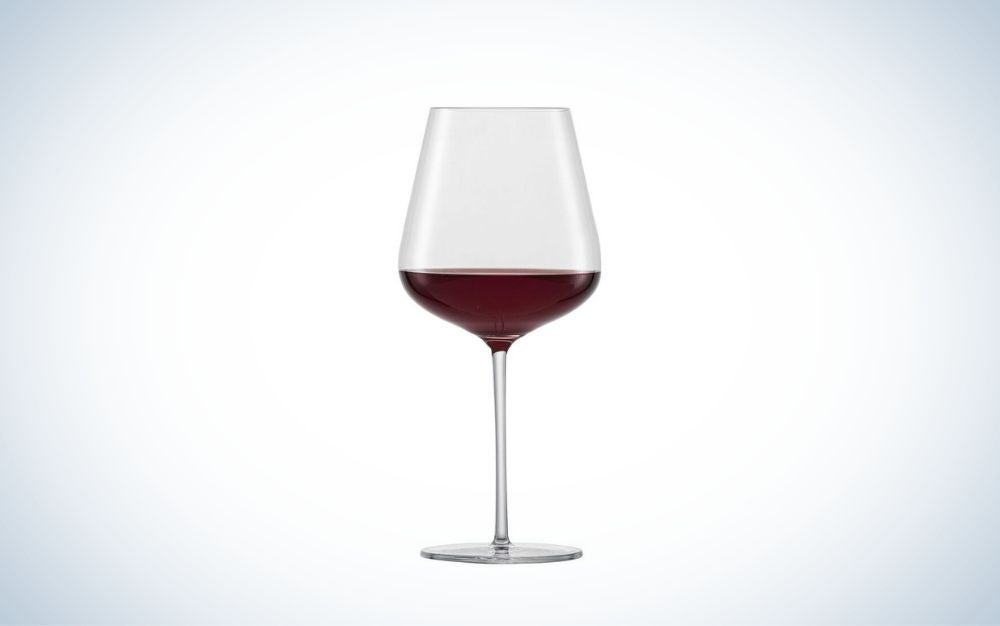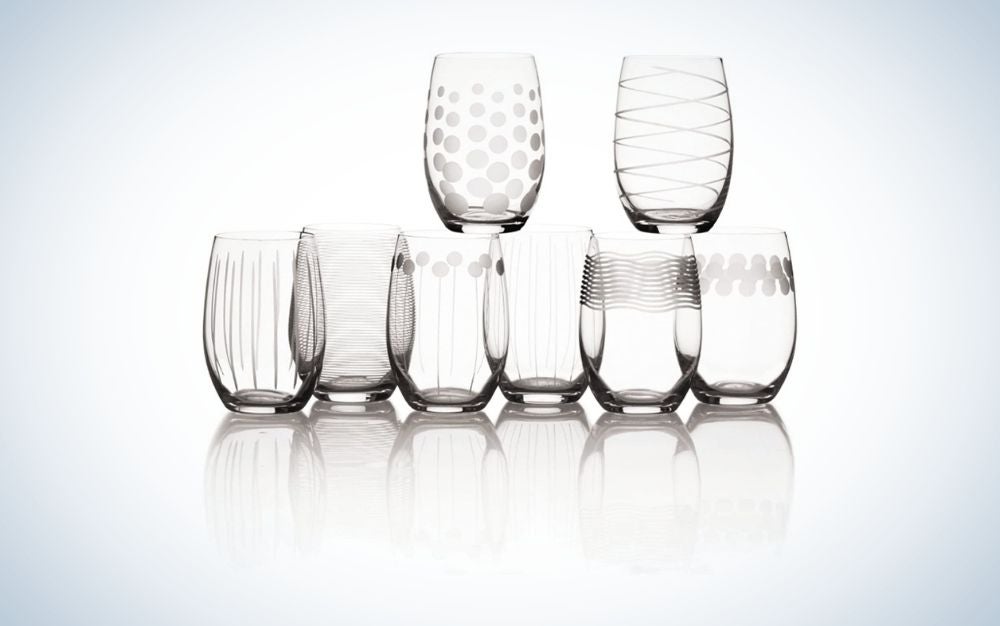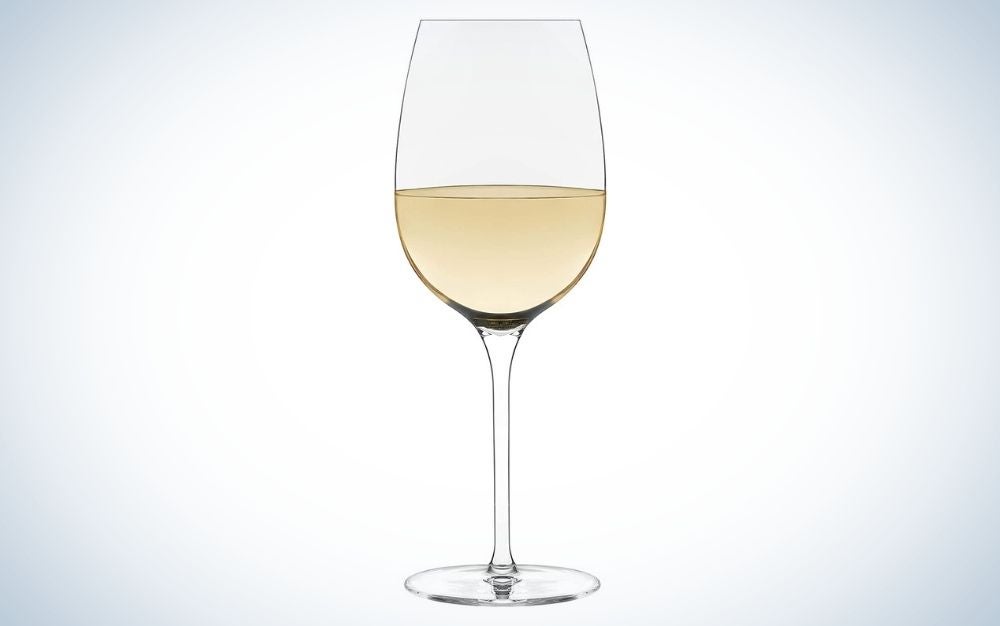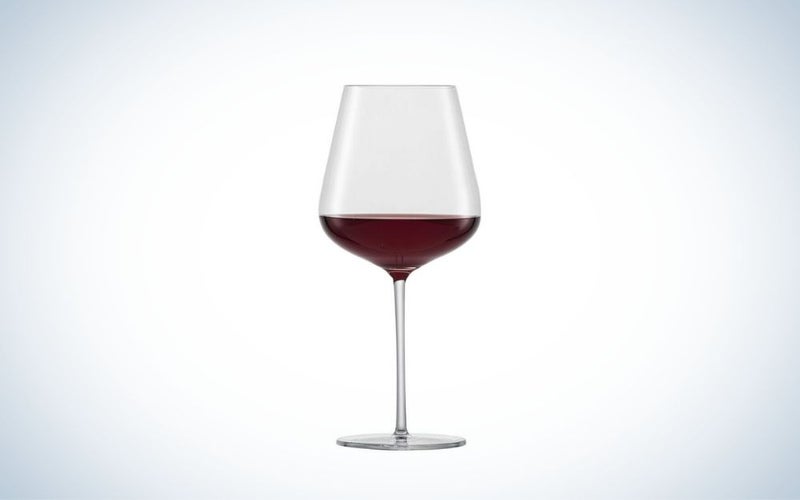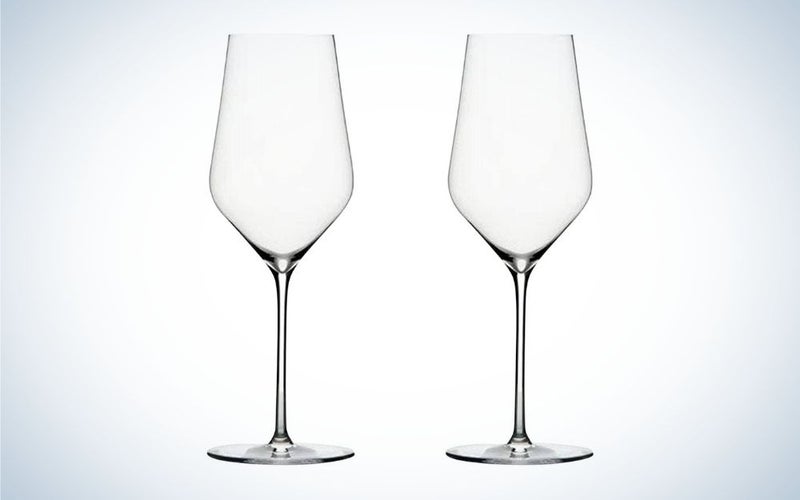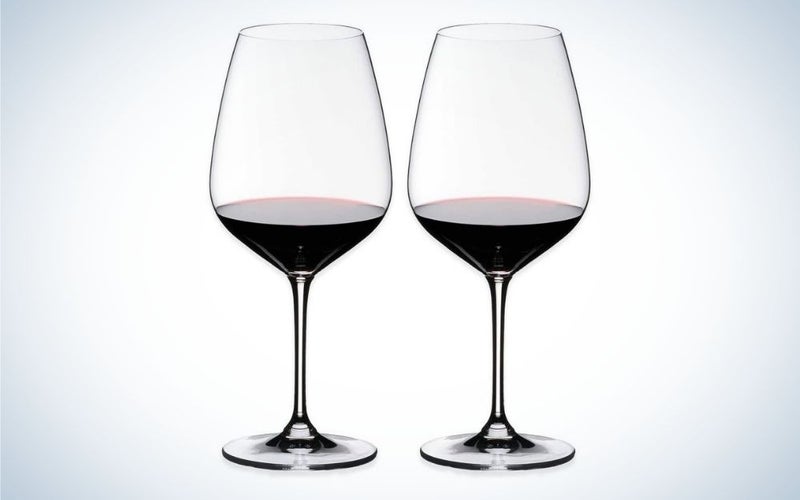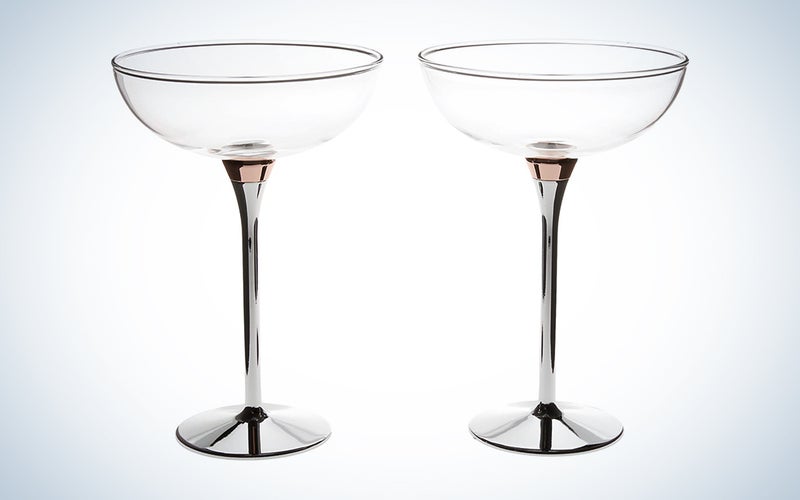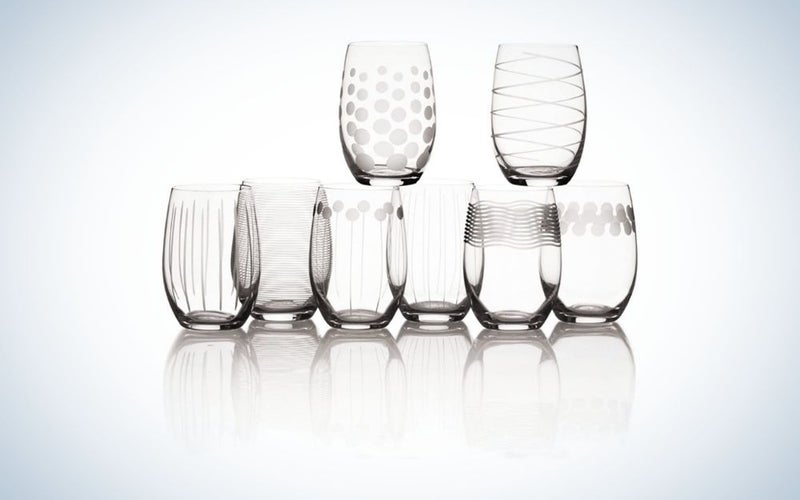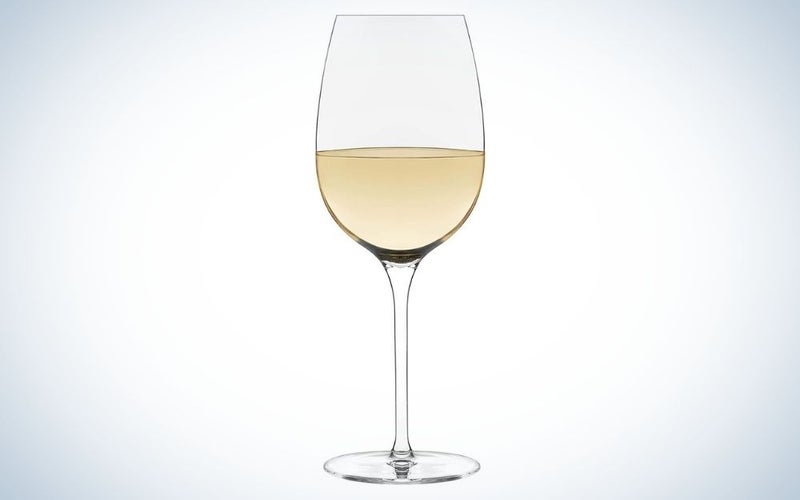We may earn revenue from the products available on this page and participate in affiliate programs. Learn more ›
Quality wine glasses will upgrade the taste, aesthetics, and enjoyment of your wine experience. There are wine glasses tailored to specific wine varieties, such as Pinot Noir or Chardonnay, as well as more versatile all-purpose wine glasses. Traditionally, most wine glasses are stemmed, but stemless glasses have become very popular in recent years as they offer a more casual, modern approach (and, practically speaking, can be less likely to be knocked over). Both crystal and glass options are available at varied price points (crystal being more expensive) and, when accompanying a commemorative bottle, they can make an excellent wedding or anniversary gift. Of course, you don’t have to reserve all of life’s little luxuries for a special occasion; the best wine glasses help you have an expertly crafted experience at any time.
- Best overall: Schott Zwiesel Vervine All-Purpose Wine Glasses
- Best for white: Zalto Denk’Art White Wine Glasses
- Best for red: Riedel Heart to Heart Cabernet Sauvignon Glasses
- Best for sparkling wine: Kate Spade New York Rosy Glow 2-Piece Champagne Saucer Set
- Best stemless: Mikasa Cheers Stemless Wine Glass
- Best budget: Libbey Signature Kentfield Estate All-Purpose Wine Glasses
How we chose the best wine glasses
I’ve covered non-alcoholic beverages before because putting something into a fancy glass is for everyone. Even if you don’t drink wine, it’s fun—and even incredibly popular right now—to drink something that’s not wine out of a wine glass. But for the wine drinkers, we considered glass shapes for specific varietals, different stem options, and prices in our considerations. We also looked at user reviews and peer recommendations and performed heavy research to narrow down our picks.
The best wine glasses: Reviews & Recommendations
No matter if it’s boxed, bottled, bottom-shelf, or topflight, these wine glasses make each sip taste like heaven.
Best overall: Schott Zwiesel Vervine All-Purpose Wine Glasses
Schott Zwiesel
Specs
- Dimensions: 4.1 x 9.1 inches
- Number in set: Six
- Dishwasher safe?: Yes
Pros
- Crystal
- Thin lip
- A great number of glasses for the price
Cons
- Still need to be careful if washing in the dishwasher
Crafted in Germany, this set of six Schott Zwiesel glasses features a thin-walled bowl, fine stem, and wide foot made from lead-free Tritan crystal—a technology using titanium and zirconium for brilliance with added strength. Although delicate, these 9.1-inch, 23.2-ounce wine Schott Zwiesel glasses have reinforced breakage-prone zones and they hold up to the dishwasher and are chip, scratch, and stain-resistant. They’re perfect for reds, whites, and sparkling wines.
Best for white: Zalto Denk’Art White Wine Glasses
Zalto
Specs
- Dimensions: 3.2 x 9.1 inches tall
- Number in set: Two
- Dishwasher safe?: Yes
Pros
- No lead
- Thin lip
- Also great for sparkling wines
Cons
- Expensive
This set of two crystal glasses is hand-blown and feather-light, made without lead. Each glass is 9.1 inches tall, 3.2 inches wide, and holds 400ml. The shape is designed with all white wine varietals (including sparkling) in mind, and a thin lip assures each sip arrives undeterred. They’re delicate stemware for delicate wines, and therefore, care should be taken with handling, but the glasses are, in fact, dishwasher safe.
Best for red: Riedel Heart to Heart Cabernet Sauvignon Glasses
Riedel
Specs
- Dimensions: 4.09 x 9.72 inches
- Number in set: 2-8
- Dishwasher safe?: Yes
Pros
- Dishwasher safe
- Good value for money
- Large volume
Cons
- Reviews note they can come in broken
Available in sets of two, four, or eight, these Riedel picks come from a manufacturer that helped pioneer the development of glasses tailored to varietals, such as this Heart to Heart series. These diamond-shaped Cabernet Sauvignon (Bordeaux) glasses are machine-blown fine crystal 9 ¾ inches tall with a capacity of 28 ¼ ounces. This well-known, well-respected, dishwasher-safe product has great customer reviews for a reason.
Best for champagne: Kate Spade New York Rosy Glow 2-Piece Champagne Saucer Set
Kate Spade
Specs
- Dimensions: 6.5 inch
- Number in set: Two
- Dishwasher safe?: No
Pros
- Rose gold and zinc alloy stem give bubbles a fun pink-metallic tint
- Adds a dose of glam to your glasses/gathering
Cons
- Wide, so take up more cabinet/bar space
- Delicate (but isn’t all glass)
- Expensive for a set of two
A nigh-perfect wedding gift, these elegant champagne coupes by Lenox—complete with sturdy metallic stems, topped with a pinkish strip—have flair without being ostentatious. That said, they are a different experience than drinking from champagne flutes. A flute will hold the wine’s carbonation and chill longer, making it a more visual and tactile experience. A coupe, meanwhile, lets off more aroma as the CO2 dissipates and your hand warms the bowl, giving you insight into the base wine, not just the bubbles. For these reasons, coupes are more typically used for sparkling wine-based cocktails and when you really warm to savor the taste, not just the texture of the champagne. However, if you’re looking to make and/or celebrate special memories, these are perfect for any host and toast that calls for a little sparkle.
Best stemless: Mikasa Cheers Stemless Wine Glass
Mikasa
Specs
- Dimensions: 2.5 x 5 inches
- Number in set: Eight
- Dishwasher safe?: Yes
Pros
- Dishwasher-safe
- High-quality etching
- Great for other kinds of drinks
Cons
- Fragile
These stemless glasses are a great choice to bring festive flair to parties. The glass is mostly clear, but the walls offer a variety of whimsical etched patterns making it slightly easy to find your glass when in social settings. Each all-purpose glass holds 17 ounces and is produced from traditional glass, making them great for cocktails, soft drinks, juices, etc., but it’s best to handwash them. A set of eight is less than $65.
Best budget: Libbey Signature Kentfield Estate All-Purpose Wine Glasses
Libbey
Specs
- Dimensions: 3.37 x 9 inches
- Number in set: Four
- Dishwasher safe?: Yes
Pros
- Great price
- Dishwasher-safe
- Good clarity
Cons
- A little delicate
These all-purpose wine glasses hold 16 ounces or 26 ounces, depending on what you buy, allowing plenty of room for swirling and sipping your favorite wines. They have a traditional 9-inch height (perfect for dishwashers) and are constructed with a ClearFire formula for enhanced clarity and strength. BPA-free, lead-free, and reasonably priced, these glasses are available four for under $45 and bring class to casual gatherings.
What to consider when buying the best wine glasses
Wine glasses have come a long way. Wine drinking dates back to ancient civilizations, with glasses used in Ancient Egypt as early as 1500 BC. An integral part of religious practices and secular indulgence all over the world, the art of glassware has been perfected for hundreds of years.
The Roman invention of glassblowing allowed for major advances. Europe has a long history of expertise in glassmaking, with Venice/Murano being the center of production. By the late 1600s/early 1700s, much of the fine European glassware was made using a mixture of minerals, including lead oxide, which led to it eventually being known as lead crystal. Adding lead oxide helped prevent cracking and created a more reflective surface. Of course, modern times have resulted in some changes. While a drinking glass made with lead is unlikely to cause any harm to the body, it is still not recommended to drink from, and lead crystal could cause damage to the body if it were used for something like a decanter, where the liquid would sit longer, and lead would have the potential to seep in. With concerns over lead safety, these are lead-free crystal and offer the same delicate elegance, brilliance, and durability that antique lead crystal offers, but without any potential issues.
Look for high-quality glass or lead-free crystal glass, which now uses barium oxide, zinc oxide, or potassium oxide in place of lead oxide. Much of the glassware still made in Europe is light in weight while remaining high in clarity and brilliance. Many crystal glasses are even durable enough to be dishwasher safe. Shapes and sizes have changed in popularity over the years, so ornate, carved crystal is not in fashion. The world’s finest restaurants and sommeliers instead recommend an elegant glass large enough to swirl and enjoy your wine’s clarity, bouquet, and flavor.
White wine glasses
White wines are delicate and aromatic and also served chilled. Due to these factors, you’ll find that white wine glasses have a longer stem than reds to reduce warming the wine with your hand. Most white glasses will also be smaller with shorter bowls, as a narrow bowl will concentrate its qualities, allowing the drinker to enjoy the perfume better.
If you are trying to buy a white wine glass with a specific grape varietal in mind, keep in mind subtle differences. Rosé, Sauvignon Blanc, and Dry Rieslings are considered higher in acid and prefer a smaller bowl than less acidic, more full-bodied wines like Chardonnay.
Great options are available in both stemmed and stemless designs. White wine stemless styles will typically be smaller than reds, as the wines do not need to breathe like reds to show their characteristics. Some people argue that stemless glasses might unwittingly warm the white wine, but for most average wine enthusiasts, it shouldn’t be a problem. If you want to get fancy with it, consider a beverage cooler to keep your bottles at the perfect temperature.
Red wine glasses
There’s research that says a daily glass of red may be good for lowering cholesterol and heightening heart health, so if you’re going to add a nightly ritual to your life, you might as well make it as pleasing as possible. Red wines can be full-bodied, medium-bodied, and light-bodied, but all benefit from taking in oxygen to the glass, known as “breathing.” Red wine will display more aroma and flavor when it is given space, which is why the best red wine glasses have larger bowls than white wine glasses. Also, the rims of red glasses are wider to allow this oxygen to reach the wine (and any aggressively earthy, oaky aromas to blow off).
To tailor your glass to your favorite varietal, consider the body of the reds you like the best. The taller, more narrow red glasses are designed specifically for tightly wound and unctuous reds that need their acidity wrangled, directing Cabernet Sauvignon- and Zinfandel-based wines to the center of the tongue. While the more rounded glasses are often for medium and light reds with more delicate scents that need to linger, the wide mouths coat the tongue. These differences may sound subtle, but they can play a major role in fully enjoying your favorite red wines.
All-purpose wine glasses
It’s important to note that if you are the type of wine enthusiast who enjoys it all, there is no reason to have grape-specific glassware. The best all-purpose glasses will work with any type of wine. By taking the middle ground in terms of size and shape, they become a versatile glass that won’t ruin the experience of either white, red, or rosé. The truth is the subtle nuances between varietal-focused glasses are just that—subtle—and most casual wine drinkers wouldn’t notice the difference that much.
As with any good wine glass, the best all-purpose options, also known as universal wine glasses, will be made with care, with quality glass or lead-free crystal that offers brilliant clarity. The uniformity of universal glasses will also offer space savings in your cabinet.
Stemless glasses
Stemless wine glasses are attractive, well-balanced, and comfortable to hold in your hand. Stemless glasses can come in the same varietal-specific (or universal) bowl shapes as traditional stemware, but losing that stem gives these an air of modernity and helps make the occasion more casual. Stemless glasses can be a smart option for parties as they are less likely to tip over when carried around and placed on various surfaces.
Some enthusiasts complain that stemless glasses are subpar because holding the glass with your hand will adversely change the temperature of the wine and, therefore, adversely affect the taste of the wine. For most people, this is so slight that it is a non-issue (and, besides, wines first served at proper cellar temperature evolve pleasingly in the glass as they warm). Stemless wine glasses are familiar to hold and come in a variety of styles and designs. They can bring sophistication without feeling fussy or fancy.
Shape and budget
When shopping for budget glasses, opting for an all-purpose design to handle any type of beverage makes sense. Typically, an all-purpose style is a Bordeaux shape, an elegant glass with a long stem that also features a slightly tapered rim (it’s a style that can also be found in stemless glasses, depending on your preference). Not only will this shape work to enhance the flavor (from Cabernet Sauvignon, Merlot, and Shiraz to Chardonnay, Riesling, Sauvignon Blanc, and rosé), it is a timeless look that will work for many years to come and coordinate with any style of dinnerware.
On a budget, you can expect to find factory-made glass options as opposed to handblown crystal. Look, however, for glass made with thinner walls for enhanced clarity, as well as laser-cut rims for chip-resistant edges. The best budget glasses will be dishwasher-safe, lead-free, and BPA-free for your health and safety.
FAQs
Q: What is the difference between glass and crystal wine glasses?
There are a few differences between glass and crystal glasses. The two might look similar from a distance, but crystal has a high proportion of minerals that allow it to be stronger while thinner and to have more clarity and brilliance. Crystal refracts light, causing a special sparkle that makes it appealing for enjoying wines. Due to the increased strength, crystal wine glasses can be lightweight yet less susceptible to breakage. While glass glasses can vary in cost and quality, typically, crystal is associated more with special occasions due to design, styling, and cost.
Q: How do you hold a wine glass?
Holding a wine glass by the stem minimizes temperature changes to the wine from your hand. To properly hold a wine glass, grasp it with your thumb and index finger and let your other fingers rest on the base.
Q: How do you clean and care for a wine glass?
If you have a cheaper glass marked as dishwasher-safe, you can put it upside down on the top shelf. However, most agree the best way to care for a glass is by washing it with dish soap and hot water. Ensure no other plates and bowls are in the way to prevent accidental breaks.
Final thoughts on the best wine glasses
- Best overall: Schott Zwiesel Vervine All-Purpose Wine Glasses
- Best for white: Zalto Denk’Art White Wine Glasses
- Best for red: Riedel Heart to Heart Cabernet Sauvignon Glasses
- Best for sparkling wine: Kate Spade New York Rosy Glow 2-Piece Champagne Saucer Set
- Best stemless: Mikasa Cheers Stemless Wine Glass
- Best budget: Libbey Signature Kentfield Estate All-Purpose Wine Glasses
The perfect wine glasses will suit your lifestyle and enhance the experience of enjoying your specific preferences (or just enjoying the entertaining experience). Whether you are looking for a receptacle designed to enhance the flavor of your favorite bottle or a simpler all-purpose style wine glass, there are plenty of beautiful wine glasses on the market to choose from, as we’ve shown.
Why trust us
Popular Science started writing about technology more than 150 years ago. There was no such thing as “gadget writing” when we published our first issue in 1872, but if there was, our mission to demystify the world of innovation for everyday readers means we would have been all over it. Here in the present, PopSci is fully committed to helping readers navigate the increasingly intimidating array of devices on the market right now.
Our writers and editors have combined decades of experience covering and reviewing consumer electronics. We each have our own obsessive specialties—from high-end audio to video games to cameras and beyond—but when we’re reviewing devices outside of our immediate wheelhouses, we do our best to seek out trustworthy voices and opinions to help guide people to the very best recommendations. We know we don’t know everything, but we’re excited to live through the analysis paralysis that internet shopping can spur so readers don’t have to.
